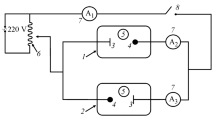Abstract
The growing interest in the electrowinning of copper has lead to several modifications including anodic reactions proposed to reduce the high energy requirement. The addition of sulphurous acid to a copper sulphate electrolyte has been studied to avoid oxygen evolution at the anode which requires a potential in excess of 2 V. In particular, the effect of different anode materials, concentration of sulphurous acid, current density, copper and sulphuric acid concentrations in the electrolyte have been investigated. Measurements of anode potential, cell voltage, current efficiency and energy consumption during the electrowinning of copper have been made using a diaphragm cell. It was found that graphite and lead coated with Ir–O2 are better electrode materials than lead and DSA anodes and sulphurous acid can be used as anodic depolarizer.
Similar content being viewed by others

References
D.J. Robinson, J. Metals 36 (1984) 43–47.
K.A. Spring and J.W. Evans, J. Appl. Electrochem 15 (1985) 609–18.
K.A. Spring and J.W. Evans, in R.G. Bautista and R.J. Weseley (Eds), Proceedings of the International Symposium on `Energy Reduction Technique in Metal Electrochemical Processes', New York (1985), pp 309–17.
K. Wiesener, Electrochim. Acta 18 (1973) 185–9.
E.T. Seo and D.T. Sawyer, Electrochim. Acta 10 (1965) 239.
A.V. Cooke, J.P. Chilton and D.J. Fray, Trans. Inst. Min. Metall. Sec. C. 98 (1989) 121–31.
R.W.Coughlin, in M.C. Kunh (Ed.), `Process Fundamental Consid. Sel. Hydrometall. Systems', (S.M.E.-AIME New York, 1981), pp 379–83.
D.M. Muir, A.J. Parker, J.H. Sharp and W.E. Waghorne, Hydrometallurgy 1 (1975) 155–68.
A.V. Cooke, J.P. Chilton and D.J. Fray, in R.G. Bautista and R.J. Weseley (Eds), Proceedings of the Symposium on `Energy Reduction Techniques in Metal Electrochemical Processes' (1985), pp. 111–41.
S. Lichusina, D. Jakimaviciute and A. Steponavicius, Chemija 1 (1995) 9–16.
S.P. Sandoval and K.P.V. Lei, in J.B. Hiskey and G.W. Warren (Eds), Proceedings of the International Symposium on `Hydrometallurgy', Fundamentals in Technology and Innovations, Milton E. Wadsworth (1993), pp. 1091–105.
P.W.T. Lu and R.L. Amman, J. Electrochem. Soc. 127 (1980) 2611–16.
K.K. Mishra and W.C. Cooper, in D.J. Robinson and S.E. James (Eds), Anodes for electrowinning. Proceeding of the sessions AIME Annual Meeting, Los Angeles. (Metallurgical Society of AIME, Warrendale, PA, 1984), pp. 13–36.
W.C. Cooper and K.K. Mishra, Hydrometallurgy 17 (1987) 305–13.
P. Gopala Krishna and S.C. Das, Proceedings of the Symposium on `Extractive Metallurgy of Gold and Base Metals', Kalgoorlie (1992), pp. 26–8.
Author information
Authors and Affiliations
Rights and permissions
About this article
Cite this article
Subbaiah, T., Singh, P., Hefter, G. et al. Sulphurous acid as anodic depolarizer in copper electrowinning Part II. Journal of Applied Electrochemistry 30, 181–186 (2000). https://doi.org/10.1023/A:1003908014531
Issue Date:
DOI: https://doi.org/10.1023/A:1003908014531



